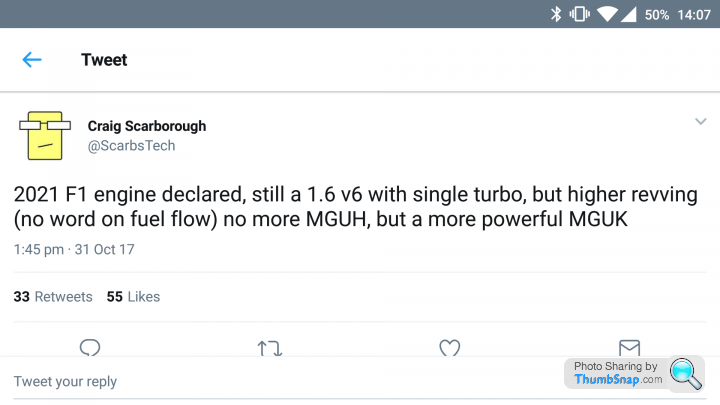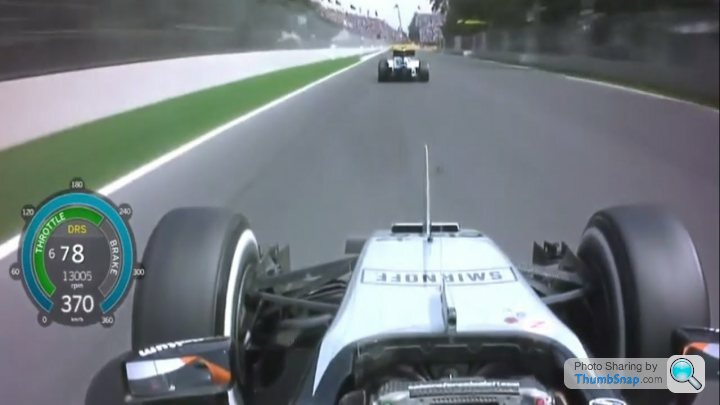New engine regs for 2021
Discussion
Rev limit same as now but fuel flow limits in the rev range massaged a bit.
+1 on the loss of heat recovery motor.
Going to be some weedy little engines compared to now. I think the loss of the heat recovery will hugely reduce the power levels seen. But manufacturers can work on refining the combustion tech, but the question would be, do manufacturers have a big desire to push ICE tech when they cannot justify it with Road relevance?
With a budget cap, they could perhaps justify F1 as a pure brand exposure/marketing thing.
+1 on the loss of heat recovery motor.
Going to be some weedy little engines compared to now. I think the loss of the heat recovery will hugely reduce the power levels seen. But manufacturers can work on refining the combustion tech, but the question would be, do manufacturers have a big desire to push ICE tech when they cannot justify it with Road relevance?
With a budget cap, they could perhaps justify F1 as a pure brand exposure/marketing thing.
I think it's time that F1 ditched any pretense about aligning with roadcar trends.
Major manufacturers don't seem that invested in hybrids other than the odd handful. It's mainly small capacity turbo charged petrol engines and rapidly-falling-out-of-fashion turbo charged diesel engines and by the time these regs come in, most manufacturers will be heading very rapidly towards EV's which, for now at least, has no place in F1. So it seems to me like the automotive industry is in a transition period as we pass from IC engines to EV's.
So my thoughts, are f k it and return to V10's and have what might be one last hurrah to big, noisy, inefficient petrol engines. Stick two fingers up to any other agenda and make the cars spectacular again.
k it and return to V10's and have what might be one last hurrah to big, noisy, inefficient petrol engines. Stick two fingers up to any other agenda and make the cars spectacular again.
That's what I'm dreaming of . Being more realistic, I'm sure the reality will be more or less exactly what we have now though I'd at least like to see the whole lot simplified a little.
. Being more realistic, I'm sure the reality will be more or less exactly what we have now though I'd at least like to see the whole lot simplified a little.
Major manufacturers don't seem that invested in hybrids other than the odd handful. It's mainly small capacity turbo charged petrol engines and rapidly-falling-out-of-fashion turbo charged diesel engines and by the time these regs come in, most manufacturers will be heading very rapidly towards EV's which, for now at least, has no place in F1. So it seems to me like the automotive industry is in a transition period as we pass from IC engines to EV's.
So my thoughts, are f
 k it and return to V10's and have what might be one last hurrah to big, noisy, inefficient petrol engines. Stick two fingers up to any other agenda and make the cars spectacular again.
k it and return to V10's and have what might be one last hurrah to big, noisy, inefficient petrol engines. Stick two fingers up to any other agenda and make the cars spectacular again. That's what I'm dreaming of
 . Being more realistic, I'm sure the reality will be more or less exactly what we have now though I'd at least like to see the whole lot simplified a little.
. Being more realistic, I'm sure the reality will be more or less exactly what we have now though I'd at least like to see the whole lot simplified a little. So here it is...
https://www.motorsport.com/f1/news/formula-1-revea...
The proposal for 2021 includes keeping the current 1.6-litre V6 turbo hybrid engine, but running it at 3000rpm higher "to improve the sound".
In order to try to simplify the internals of the power unit, the MGU-H will be removed, and several prescriptive design parameters will be introduced to "restrict development costs and discourage extreme designs and running conditions".
These will include internal and external parameters, with the latter allowing for what the FIA described as "a plug-and-play engine/chassis/transmission swap capability".
A single turbo with dimensional constraints and weight limits will be mandated, while a standard energy store will be introduced alongside control electronics, which have long been standard in F1.
The MGU-K will be made more powerful, with a focus on manual driver deployment of the additional power, similar to the way KERS was used when it was first introduced into F1 in 2009.
This feature will also give drivers the option to save up energy over several laps to increase the tactical elements involved in racing.
EDIT to add a link the FIA press release - https://www.fia.com/news/fia-and-formula-1-set-out...
https://www.motorsport.com/f1/news/formula-1-revea...
The proposal for 2021 includes keeping the current 1.6-litre V6 turbo hybrid engine, but running it at 3000rpm higher "to improve the sound".
In order to try to simplify the internals of the power unit, the MGU-H will be removed, and several prescriptive design parameters will be introduced to "restrict development costs and discourage extreme designs and running conditions".
These will include internal and external parameters, with the latter allowing for what the FIA described as "a plug-and-play engine/chassis/transmission swap capability".
A single turbo with dimensional constraints and weight limits will be mandated, while a standard energy store will be introduced alongside control electronics, which have long been standard in F1.
The MGU-K will be made more powerful, with a focus on manual driver deployment of the additional power, similar to the way KERS was used when it was first introduced into F1 in 2009.
This feature will also give drivers the option to save up energy over several laps to increase the tactical elements involved in racing.
EDIT to add a link the FIA press release - https://www.fia.com/news/fia-and-formula-1-set-out...
Edited by thegreenhell on Tuesday 31st October 14:11
Doink said:
We already have a 15,000 rev limit but they don't get near that stopping at 12,000 because of the fuel flow limit, so they've added 3k on the rev limit, is that by allowing a higher fuel flow rate to enable 15k to be reached or is it 18k with even higher fuel flow still?
My guess would be that the constraints on the turbo will reduce the viable boost pressure which will make it necessary to raise the revs higher to use the current fuel flow. kambites said:
Doink said:
We already have a 15,000 rev limit but they don't get near that stopping at 12,000 because of the fuel flow limit, so they've added 3k on the rev limit, is that by allowing a higher fuel flow rate to enable 15k to be reached or is it 18k with even higher fuel flow still?
My guess would be that the constraints on the turbo will reduce the viable boost pressure which will make it necessary to raise the revs higher to use the current fuel flow. CraigyMc said:
TBF that's not exactly representative. He's obviously in a DRS tow on a long straight in top gear, hence revving beyond the usual range. They usually upshift between 11 and 12k revs. They never get close to the current 15k rpm limit.Gassing Station | Formula 1 | Top of Page | What's New | My Stuff






